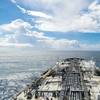LNG (liquefied natural gas) is natural gas, primarily methane, which has been cooled to its liquid state at -260°F (162.2°C). Liquefying natural gas reduces the volume it occupies by more than 600 times, making it a practical size for storage and transportation. LNG (the liquid itself) is not flammable or explosive
How is LNG shipped?
• Specially designed ships are used to transport LNG to U.S. import terminals. The ships can carry LNG over long distances and are constructed of specialized materials and equipped with systems designed to safely store LNG at temperatures of -260 °F (-162.2°C)
• All LNG ships are constructed with double hulls. This construction method increases the integrity of the hull system, provides insulation for the LNG and provides protection for the cargo tanks in case of an accident
• Three basic tank designs have been developed for LNG ship containment and transport: prismatic free-standing, spherical, membrane
How are LNG tankers and facilities being kept secure?
Security measures for the offshore portions of marine terminals are required by U.S. Coast Guard regulations. The Coast Guard prevents other ships from getting near LNG tankers, while in transit or docked at a terminal.
Dispelling the explosion myth
• LNG is not explosive. Although a large amount of energy is stored in LNG, it cannot be released rapidly enough to cause the overpressures associated with an explosion
• LNG vapors (methane) mixed with air are not explosive in an unconfined environment
Source: Federal Energy Regulatory Commission (FERC)
Sponsored Content
Chris-Marine’s solutions help to prolong engine lifetime

Subscribe for
Maritime Reporter E-News
Maritime Reporter E-News is the maritime industry's largest circulation and most authoritative ENews Service, delivered to your Email five times per week










